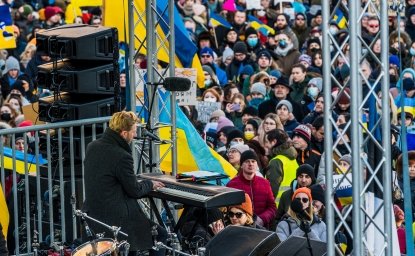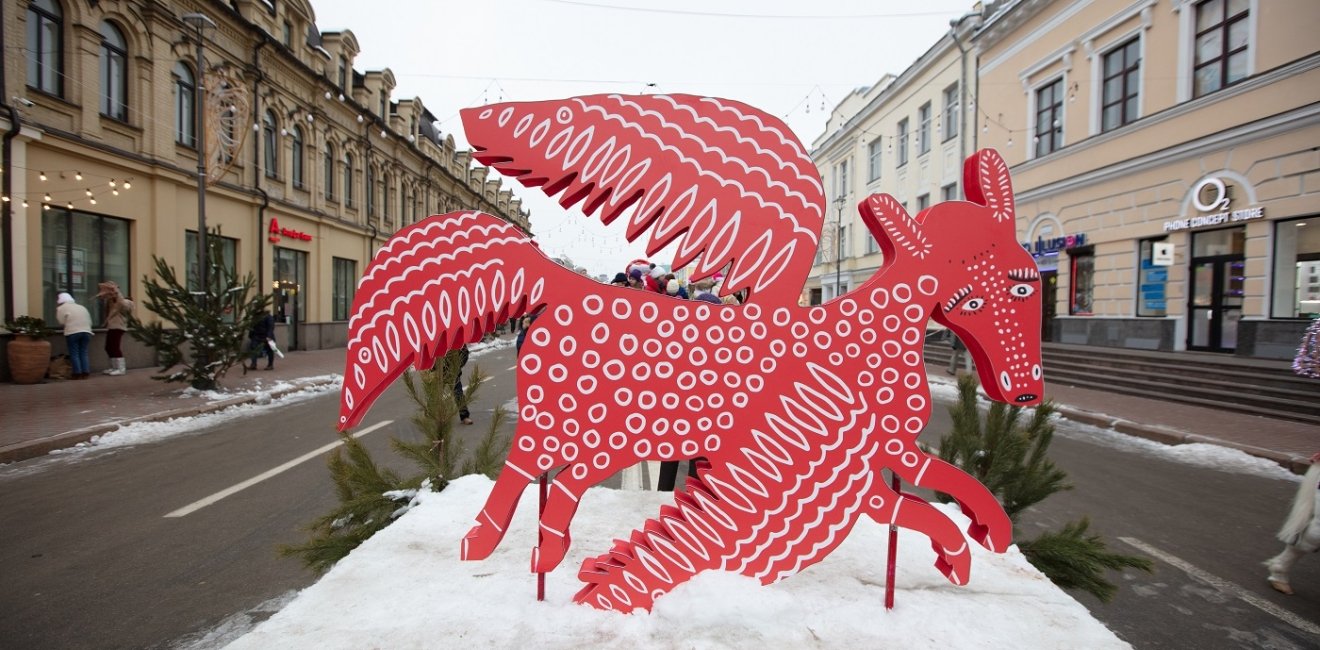
A blog of the Kennan Institute
BY BLAIR A. RUBLE
The Russian invasion has challenged Ukrainians of all ages to proclaim their cultural distinctiveness in the face of the Russian denial of Ukraine as anything other than part of a fictional “Russian world.” This attack on national identity is undeniable in Russia’s wanton destruction of Ukrainian cultural symbols that otherwise have no military value. The destruction of the Prymachenko Museum in Ivankiv offers a particularly poignant example of this policy.
The Russian army quickly captured the village when it invaded Ukraine earlier this year. The occupying forces purposefully burned the museum to the ground as part of a campaign to destroy symbols of distinctive Ukrainian culture. Local residents somehow saved much of the work from the conflagration.
Beloved folk artist Maria Prymachenko’s vibrant, joyous, magical paintings, drawings, and embroideries have been celebrated for decades for her very personal vision rooted in Ukrainian folk motifs. Prymachenko’s superficially naïve, self-taught style made deceptively simple use of complex color pallets, forms, and materials. According to some accounts, Pablo Picasso declared, following a visit to an exhibition of her work in Paris, “I bow down before the artistic miracle of this brilliant Ukrainian.”
The delight that is so visible in her art belies a life of loss. Born in 1908 to a peasant family in the village of Bolotnia, 20 miles from Chernobyl, Prymachenko contracted polio as a child, an illness which forced her to drop out of school after only four years. She was fascinated by the natural world around her and began to draw and paint on the walls of her house. Her mother taught her embroidery, which eventually brought her to the attention of artists in the folk-art center of Ivankiv. She soon was showing her work in major Soviet cities and abroad.
Able to stand unaided following two operations, she met her fiancé Vasyl Marynchuk in Kyiv and, in March 1941, gave birth to their son Fedir (who would become a noted folk artist himself). Marynchuk died fighting in Finland in WWII and the Nazis killed her brother. Left with no other option in a country devastated by war, Maria and Fedir returned to Ivankiv to work on a collective farm.
Prymachenko, by this time, had moved beyond embroidery to drawing and painting, using an increasingly colorful palette. Her works appeared in major exhibitions, and she won the Taras Shevchenko National Prize of Ukraine in 1966. She lived in the village until her death at age 88 in 1997. Her reputation continued to grow, with UNESCO declaring 2009 the year of Prymachenko. A museum dedicated to her art in Ivankiv attracted a steady stream of visitors despite its somewhat remote location.
While Prymachenko’s works have never fallen completely from view, her art nonetheless failed to speak to a rising generation of Ukrainians raised in large cities. But news of the Russian devastation changed the meaning of Prymachenko’s art for thousands of Ukrainians overnight. Her art represented an expression of a particularly Ukrainian imagination. Destruction of her art represented an assault on Ukrainian identity and culture broadly. Her ability to communicate joy and magic through dark times, her talent at combining Ukrainian folk motifs with a highly personal style, and her astounding use of colors spoke anew to Ukrainians trying to make sense of the loss of their own hopes and dreams in this devastating war.
The countryside never seems distant in Ukrainian cities. A majority of Ukrainian urban residents have moved from the village only one or two generations before. Folk kitsch adorns numerous restaurants and bars, recreating imaginary villages with fake cottages, fake haystacks, and mostly fake (although sometimes real) farm animals attracting tourists and nostalgic city dwellers to their tables. Prymachenko’s art operates at a different level, demonstrating how an imaginary past animates a contemporary Ukraine confronting an existential challenge. Fittingly, two of her works were shown at the Venice Biennale this year.
In July, Lviv’s Sheptytsky National Museum opened a major exhibition of Prymachenko’s later work. The exhibits’ five rooms present the museum’s own collection, together with more than 80 works held in the private collection of Kyiv art critic Eduard Dymshits. Many of the works on display address the horrors of war as personal loss rather than abstraction. They speak directly to viewers finding sanctuary in a museum that is surrounded by war.
The Russian invasion has challenged Ukrainians of all ages to proclaim their cultural distinctiveness in the face of the Russian denial of Ukraine as anything other than part of a fictional “Russian world.” This attack on national identity is undeniable in Russia’s wanton destruction of Ukrainian cultural symbols—such as the Prymachenko museum—that otherwise have no military value.
The curators at the Sheptytsky Museum have chosen well in their selection of an exhibit at this moment in history. Prymachenko’s art speaks to Ukrainians anew as they try to affirm their lives in the face of murder.
The opinions expressed in this article are those solely of the author and do not reflect the views of the Kennan Institute.
Author

Former Wilson Center Vice President for Programs (2014-2017); Director of the Comparative Urban Studies Program/Urban Sustainability Laboratory (1992-2017); Director of the Kennan Institute for Advanced Russian Studies (1989-2012) and Director of the Program on Global Sustainability and Resilience (2012-2014)

Kennan Institute
The Kennan Institute is the premier US center for advanced research on Eurasia and the oldest and largest regional program at the Woodrow Wilson International Center for Scholars. The Kennan Institute is committed to improving American understanding of Russia, Ukraine, Central Asia, the South Caucasus, and the surrounding region through research and exchange. Read more

Explore More in Focus Ukraine
Browse Focus Ukraine
The Arts of War: Ukrainian Artists Confront Russia

Talking to the Dead to Heal the Living

Ukrainian Issue in Polish Elections

